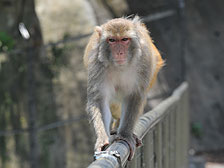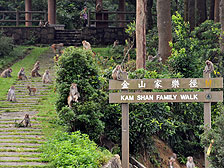
Unlimited access:
Agile monkeys can traipse across high railings with ease.
Unlimited access:
Agile monkeys can traipse across high railings with ease.

Family fun:
As the monkey population grew near Kam Shan, or "Golden Hill", the area came to be known as Monkey Mountain.
Family fun:
As the monkey population grew near Kam Shan, or "Golden Hill", the area came to be known as Monkey Mountain.

Birth control:
A veterinarian sterilises a female monkey to help keep their numbers from multiplying.
Birth control:
A veterinarian sterilises a female monkey to help keep their numbers from multiplying.
Please, please don’t feed the monkeys
July 29, 2012
Visitors to Kowloon country parks may be surprised, and delighted, to see troops of monkeys at play. These agile creatures have truly made themselves at home and can be seen swinging from tree to tree, grooming each other, or even swimming in the reservoirs.
Experts estimate there are about 2,000 monkeys now living in Hong Kong, many descended from monkeys introduced to the wild about a century ago.
As work on the Kowloon Reservoir was drawing to a close in the early 1900s, people discovered Strychnos, the flowering plant that is the source of strychnine poison, growing nearby. Although the plant can be dangerous to people, monkeys enjoy eating it and are not harmed by it. So a few imported monkeys were released there, with the expectation that they would eat the plants and make the reservoir safer for people.
The monkeys quickly adapted to the new environment, and it didn’t take long for them to breed and multiply, rapidly spreading to Kam Shan and Lion Rock Country Parks, Shing Mun Country Park and Tai Po Kau Nature Reserve. Now, about 80% of them gather in Kam Shan - now known as 'Monkey Mountain' - and Lion Rock Country Parks, where they can cause quite a nuisance.
Feeding triggers nuisance
Agriculture, Fisheries & Conservation Department Wetland & Fauna Conservation Officer (Enforcement) Shek Chung-tong attributes the growth in the monkey population to people feeding them.
As many visitors brought food for them, frequent contact led monkeys to not fear people, and to come to expect food from them. People carrying food in plastic bags became targets as monkeys learned to snatch the goods from them. As more residential areas have sprung up close to the monkeys' habitat, they began frequenting nearby buildings in search of food, upending rubbish bins and disturbing residents.
Monkey birth control
To control wild monkey population growth, the department launched a large-scale contraceptive programme in 2007, based on other countries' experiences in trying to curb problem animal populations.
The department sets a green steel trap, about the size of a twenty-foot cargo container, with gates open at either end - and delicious monkey treats on the floor to lure them into the centre. When there are enough monkeys inside, the gates are lowered, and the contraceptive team springs into action, first sedating the animals. Male monkeys are given a chemical vasectomy.
Initially, female monkeys were given a vaccine to stop them from becoming pregnant. As it was effective for only three to five years, the females would have to be rounded up and trapped again and again. So in 2009, they switched to a permanent surgical method. All treated monkeys are injected with a microchip for easy future identification.
Ocean Park Conservation Foundation is the subcontractor in charge of the monkey desexing programme. It has proven effective. Up to last August, more than 1,600 monkeys, or about 70% of the total population, had been treated. A population survey last year showed the total wild monkey population had fallen 6.9% in 2010, and 8.6% in 2011. The birth rates of the troops which received treatments in the past two years dropped 30% to 60%.
Natural diet best
To ease the conflicts that arise when monkeys turn to visitors for food, the department adopts a two-fold strategy. To encourage monkeys to stay within the country park confines, it has planted about 300,000 fruit trees in country parks, of varieties that appeal to them. They include the Strawberry Tree, Silver Back Artocarpus, Hog Plum, Lingnan Garcinia and Myrobalan. In all, there are more than 200 types of plants that monkeys can eat.
The department also prohibits the feeding of wild monkeys and other wild animals under the Wild Animals Protection Ordinance. People convicted of feeding monkeys could face a fine of up to $10,000. Large banners have been erected at monkey gathering places to remind visitors not to feed them. Monkeys generally do not harass visitors if they do not offer them food, or carry food the monkeys can see - and try to grab.
Despite the potentially heavy penalty, 53 people were convicted for feeding monkeys in 2011. Up to the middle of 2012, 48 convictions were recorded.
Protected species The department has also established a special team to drive away or capture stray monkeys in residential areas upon receiving complaints. It also advises nearby property-management offices of buildings that monkeys frequent, reminding them to manage outdoor waste properly and use monkey-proof rubbish bins with secure closing lids.
Officers from the department patrol the country parks to monitor the monkeys' health and living conditions. It is not unusual to find monkeys with injuries, but Mr Shek said these are usually the result of fights between monkeys who challenge the troop leader.
Some injuries may have been inflicted by people, though, Mr Shek said, although no one has been caught in the act. The department recently stepped up patrols at Kam Shan and Lion Rock Country Parks and maintains close co-operation with Police.